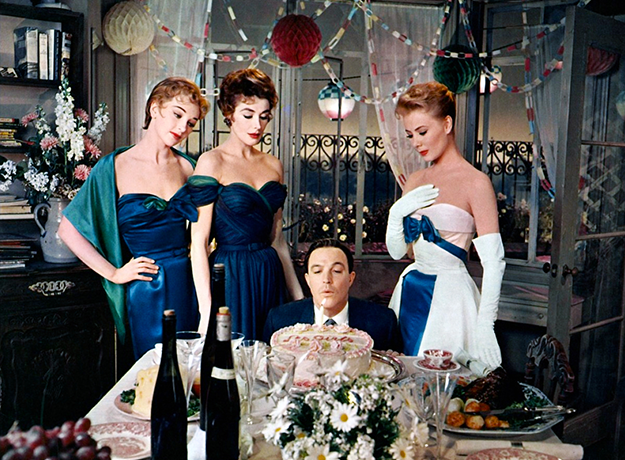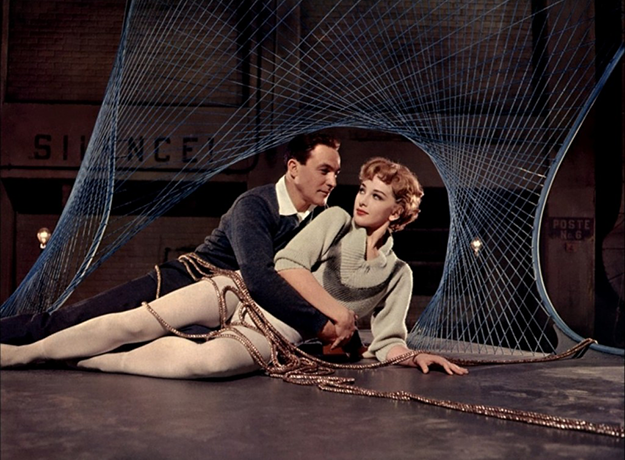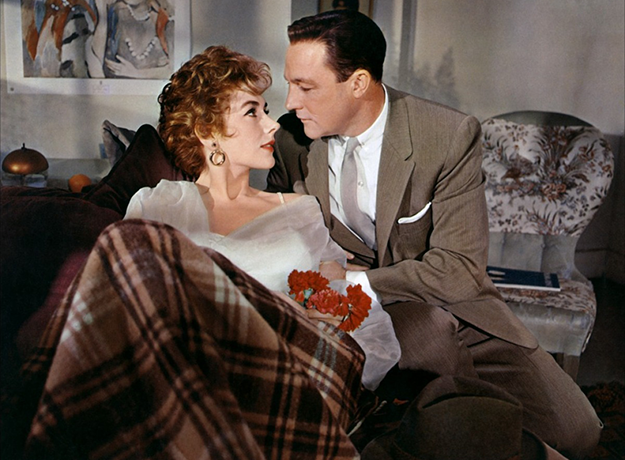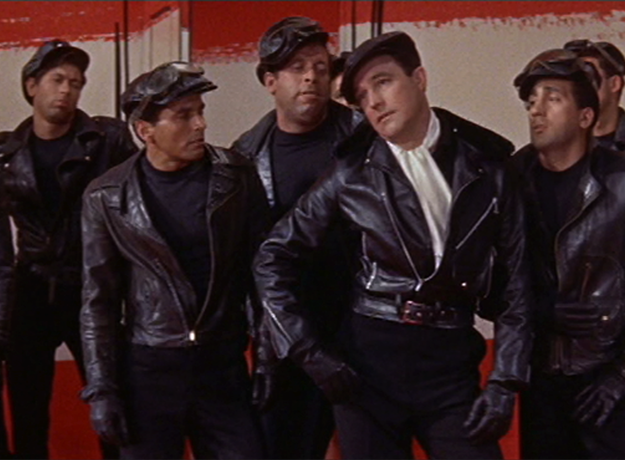Les Girls (1957)

The great musicals of the late Fifties have a curtain-call feeling to them, a sense the artists knew their champagne was about to be confiscated. It’s the finale—time to give it all you got, kid. And of all the era’s big-budget jewels, few give me sharper pleasure, or a bigger Cassandra-stab of regret, than Les Girls, made at MGM in 1957. There were plenty of “three girls” movies in the Fifties, but none of them are as sizzlingly adult as this gender-flipped Rashomon about three showgirls vying for the caddish heart of Gene Kelly, the song-and-dance man who runs the troupe.
It was ostensibly based on a short story by Vera Caspary, of Laura fame. But producer Sol C. Siegel, fresh off a hit with High Society, hired that movie’s screenwriter, John Patrick, and told him to do whatever he wanted with the premise. Patrick came back with a three-pronged structure: in the present, we’re in a British courtroom watching a libel suit brought by Angèle (Taina Elg) against Sybil (Kay Kendall). Almost a decade before, Angèle and Sybil were living in Paris with American dancer Joy (Mitzi Gaynor), and together they toured postwar Europe with Barry Nichols (Gene Kelly) as an act called, naturellement, “Barry Nichols and Les Girls.”
But Sybil, now the titled wife of a British toff (Leslie Phillips), has written a memoir. And Angèle, herself cozily and wealthily married to Pierre (played by Jacques Bergerac and his magic glowing teeth) is hopping mad about the tales that Sybil has tattled. First, we get a flashback to illustrate Sybil’s testimony about how the act broke up; then, it’s Angèle’s turn; and finally, Barry takes the stand. The finished script bore so little resemblance to anything the talented Caspary had written that she joked she was the highest paid writer in the world: $80,000 for two words, “Les Girls.” But Patrick’s screenplay gives Cukor the chance to rhyme shots from segment to segment, play musical numbers from different angles, show a scene from a window above and then down on the ground with the characters.

George Hoyningen-Huene, a frequent Cukor collaborator, had the title of “color coordinator,” and he wanted the look to mimic a puff of cigarette smoke, save those moments when color bursts in. The movie’s ravishing design is like a 3-D puzzle, and some pieces are deliberately out of place. Barry’s show seems only slightly smaller than the Folies Bergère, with about a hundred showgirls in lavish costumes, a full orchestra, even clowns for the act intervals, and yet the stars are living and traveling quite modestly. I’ve seen Les Girls at least a half-dozen times and I still do not understand the geography of the girls’ attic flat, which overlooks a narrow courtyard on one side, an even narrower street on the other, and yet has a terrace with a view that suggests they’re at the top of Sacre Coeur. The steps in the apartment go this way and that, rooms open off one another like the layout was done by Salvador Dalí, and just when I am sure they’re in the kitchen, the camera shifts and presto, it turns out they’re in the sitting room. The backstage areas are just as complex; there are virtually no street scenes. The film is a maze of narrow stairways and walkways, people popping in and out of doors and glimpsed through windows—we are eavesdropping, looking through a keyhole, getting only part of the picture at any one time.
Cukor’s camera and Huene’s color vision combine in the striking way the flashbacks begin. Cukor pans slowly from Sybil in the witness box, across wood panels, then a shelf of legal books, then another (spatially impossible) set of legal books, and finally the shot picks up the flowers on the terrace of les girls’ apartment. When it’s time for Angèle’s recollections, there is a slow, elegant dissolve from her on the stand to her face framed by the flowers in the local market. And when Barry steps up, once again there’s a slow pan from the witness box to his past self, but this time the “flowers” in the shot are the chorus girls during a set change, framing Barry as he moons over the one dancer he did love.
No one familiar with how such movies work will be surprised to hear that Barry, despite having chased Angèle and Sybil, is smitten with wholesome, sensible Joy. But a director has all kinds of ways of showing which actor he favors, and in this film, it’s obviously not Gaynor (whom Cukor didn’t want for the part). Nor is it Elg, an arresting Finnish ballerina who acquits herself well and got to lip-sync the best song in the score, “Ca, C’est L’Amour.” It’s Kendall, model-slender, with that Gainsborough face and endless legs and arms. By far the best comedienne of the bunch, it’s partly Kendall’s sheer adorableness that draws the eye, but Cukor has small ways of favoring her, just by making sure the unique Kendall profile was in the frame. And when she has her duet with Kelly, a Porter trifle called “You’re Just Too, Too,” you get the sense Cukor barely knows the great Gene is there.

Kendall’s height puts her dead center in the title number “Les Girls,” and even though it’s pretty easy to tell she’s the only non-dancer, she moves with flair. Choreographer Jack Cole was used to non-dancers (he’d done the immortal numbers for Marilyn Monroe and Jane Russell in Gentlemen Prefer Blondes, among others) so he gives the trio a bunch of hip-swiveling maneuvers that more than do the trick. Plus, there is a whole lot going on here, as girls burst out of everywhere to dance down ramps with the angled jazzy moves that were Cole’s signature. The chorus mimics Watusis, Brazilians, Indians, Chinese—nearly all of them white dancers in makeup, which is extremely unfortunate, but the number swings nonetheless. I am especially fond of the dancers who, for reasons I wish Cole were still around to explain, strut across the stage with unlit pipes clenched in their teeth.
But Cole’s masterpiece in this film is “Ladies in Waiting,” a burlesque number for the three girls, performed in Louis XV drag. The back of the costumes (designed by Orry-Kelly, who won an Oscar) reveal flesh-toned tights that are as close to a naked rearview as an American movie could get in 1957, and sitting right near the bull’s-eye is a big blue bow. These 18th-century stripper getups don’t lend themselves to big moves and so the dance is largely a march, but Cole uses the three performers like a game of three-card monte, constantly switching them around in the line and making us search for what’s happening. And Cukor has a blast, too; there’s an abrupt cut to a view of King Louis in bed, and it’s only when the camera switches back to show the girls whispering to each other on stage that it’s clear what appeared to be a solid backdrop was actually a scrim. (Like I said, Barry Nichols had a big budget for his little song-and-dance team.)
The number is repeated in the second flashback, and here the camerawork gets even crazier, Cukor moving in close on the girls’ faces, then shifting in back of them, the better to observe Sybil (who’s drunk) nearly fall into the orchestra pit. Gene Kelly himself choreographed a smoking hot duet for himself and Gaynor, a parody of The Wild One called “Why Am I So Gone About That Girl.” It’s vintage Kelly, a great number in itself, but it’s “Ladies in Waiting” that seems uncannily modern, with its strange, abrupt angles and close views of the girls’ sweaty faces.

Despite these high spirits, that melancholy feeling that clings to Les Girls is inevitable. The film marked an awful lot of endings: Cole Porter’s last film score, and the last musical either Sol Siegel or Gene Kelly ever made at MGM. Kendall was beginning to feel the symptoms of the leukemia that would kill her three years later. Gaynor would go on to make the massive hit South Pacific for Fox, then see her movie stardom fizzle out as the peppy Technicolor dancing that made her name gave way to rock ’n’ roll comedies. The movie was supposed to be the breakout part for Elg, but she had signed her contract at MGM just in time to help turn out the lights. “When I asked for a release from my contract,” she told an interviewer in 2010, “I think they were as relieved as I was. There were only 14 actors still there full-time. When I’d signed a few years earlier, there had been between 40 and 50.” At MGM, there’d be the glory of Gigi the next year, and then… Bells Are Ringing. Jumbo. The Unsinkable Molly Brown.
Les Girls was a hit, but with critics it often seems more tolerated than loved. Cukor biographer Patrick McGilligan opined that “Les Girls turned out stunningly beautiful but empty, its innocence fatuous, its story without any cleverness or depth of characterization.” I’d say the one flaw is the lack of chemistry between Gaynor and Kelly (who was going through a divorce); but “innocence” is not a word that belongs anywhere near this musical, with its revolving lies, hopping bed partners, double-entendres and strutting striptease choreography. At the very end, on the witness stand, Barry says that after the act broke up, he went to California and started a chain of orange-juice stands. The makers of Les Girls knew there is one truth: business wins out over show.
Les Girls screens Friday February 5 as part of the series “All That Jack (Cole)” at the Museum of Modern Art.
Farran Smith Nehme writes about classic film on her blog, Self-Styled Siren, and recently published her first novel, Missing Reels. She is a member of the New York Film Critics Circle.







